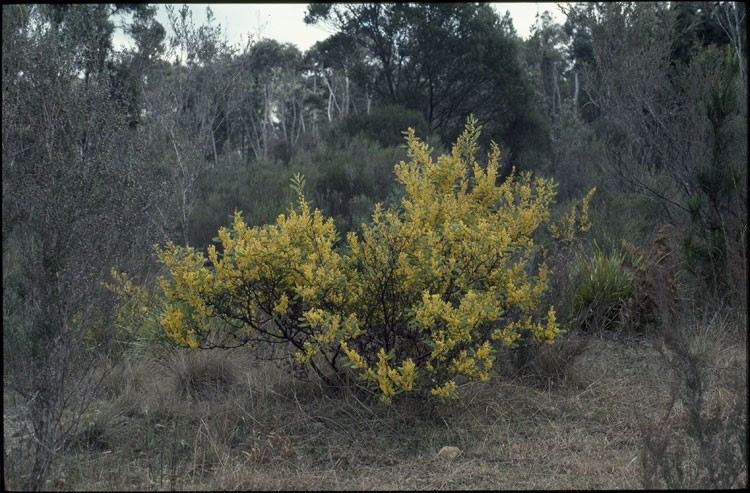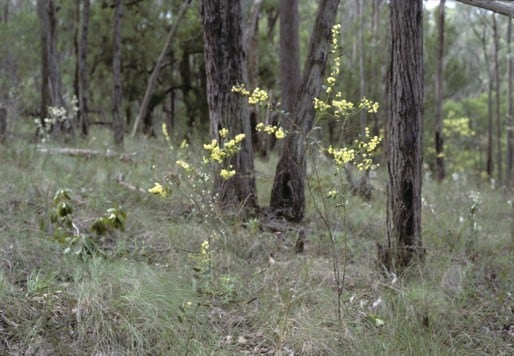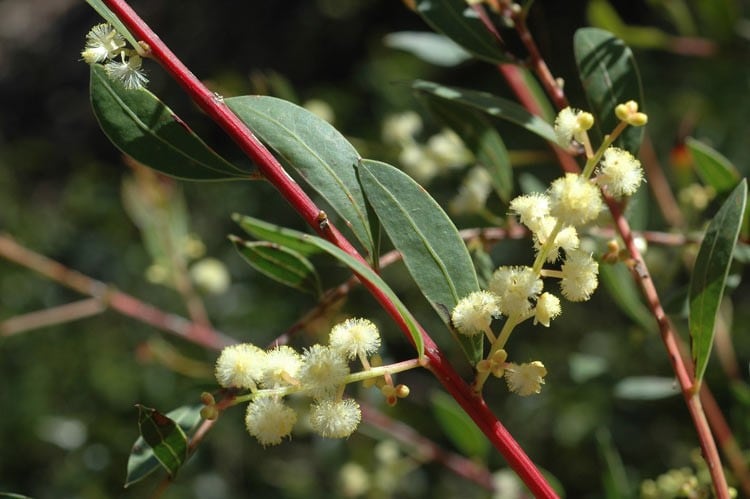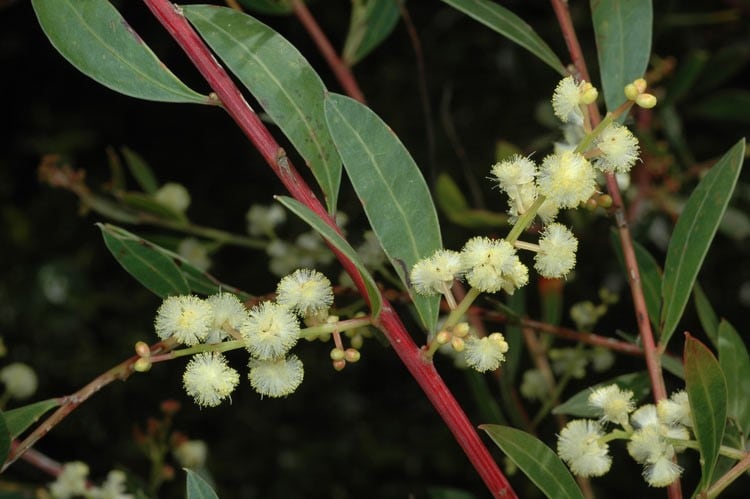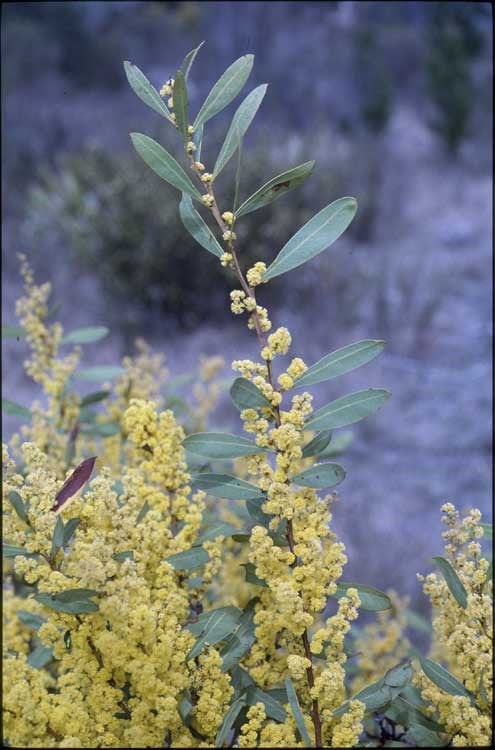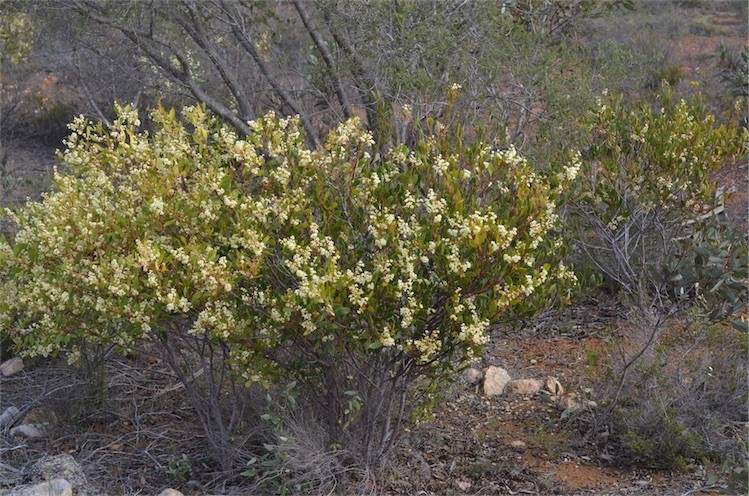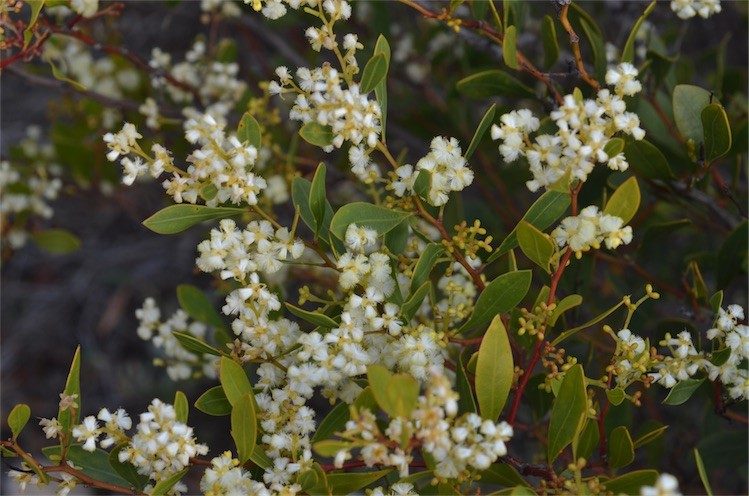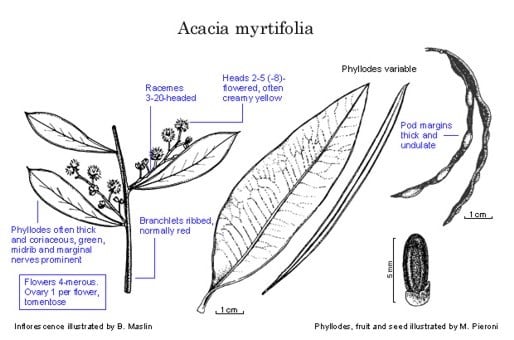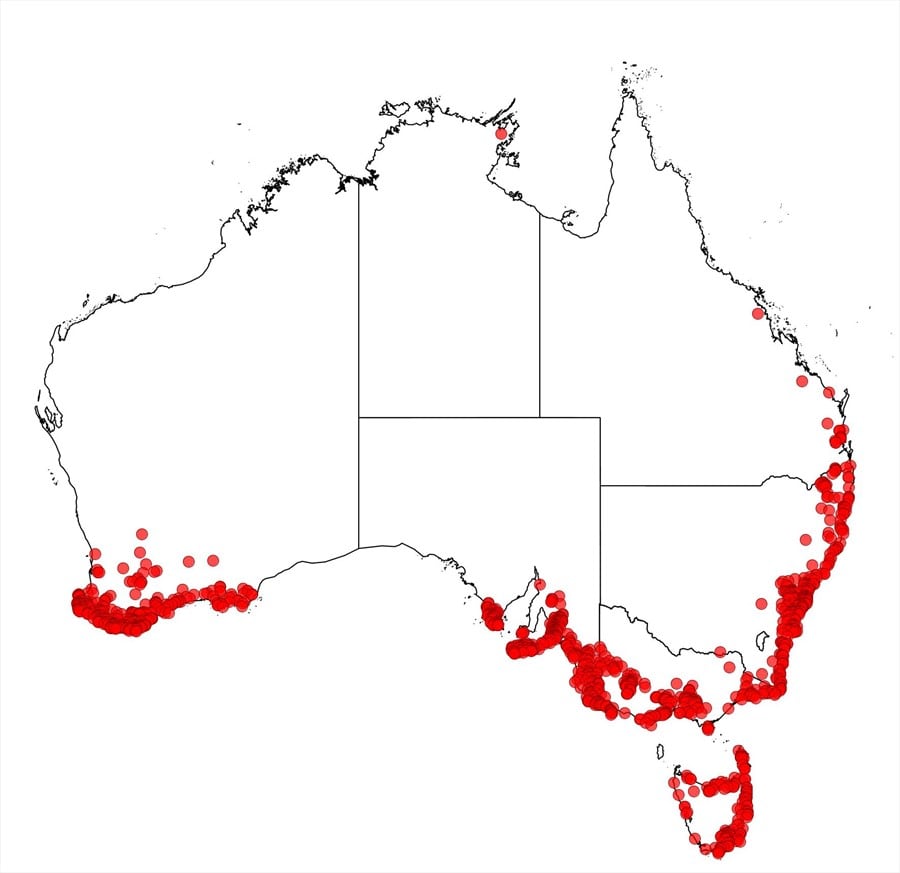Acacia myrtifolia (Sm.) Willd.
WATTLE
Acacias of Australia
Common Name
Myrtle Wattle, Red Stem Wattle (Red-stemmed Wattle), South Australian Silver Wattle
Family
Fabaceae
Distribution
Widespread and common in temperate southern Australia, occurring in all States (except N.T.).
Description
Glabrous bushy shrub, usually 0.5–3 m high. New shoots often red. Branchlets angled, prominently ribbed, normally red. Stipules early caducous. Phyllodes erect, ±oblique, commonly narrowly elliptic to oblanceolate, sometimes linear to linear-elliptic, normally 2–13 cm long, usually 4–30 mm wide, acute or obtuse-mucronate, sometimes coarsely pungent, usually thick and coriaceous, smooth, green; midrib and marginal nerves prominent; lateral nerves absent or obscure; gland prominent, mostly 0.5–2 cm above pulvinus. Inflorescences 3–20-headed racemes; racemes axes 1–6 (-12) cm long; peduncles (2–) 3–12 mm long, stout; heads ±globular, 2–5-flowered, sometimes to 8-flowered, usually creamy yellow. Flowers 4-merous, large; sepals united into a truncate to sinuously lobed calyx; ovary tomentulose. Pods erect, linear, curved, to 9 cm long, 3–5 mm wide, crustaceous to subwoody; marginal nerve thick, undulate. Seeds longitudinal, narrowly oblong, 3.5–4.5 mm long, shiny, brown or greyish brown; aril terminal.
Habitat
Grows in sand or sand over laterite or granite, in forest, woodland, scrub or heath, often in coastal or near-coastal areas.
Specimens
W.A.: near Spencer’s house [Strawberry Hill Farm, Albany], L.Preiss 920 (G, LD, MO, NY, P, STR). S.A.: Manning Reserve near MacLaren Flat, D.J.E.Whibley 1331 (AD). Qld: Kroombit Tops, c. 65 km SSW of Gladstone, W.J.F.McDonald 1014 (BRI). N.S.W.: Belmont North, T.Tame 2039 (PERTH). Vic.: Dandenongs, Menzies Ck area, J.H.Ross 2791 (AD n.v., BRI n.v., CANB n.v., HO n.v., MEL n.v., PERTH). Tas.: Clarkes Is., Furneaux Group, J.S.Whinray 1692 (MEL).
Notes
Acacia myrtifolia together with eight close relatives from W.A., namely A. celastrifolia, A. clydonophora, A. disticha, A. durabilis, A. heterochroa, A. nervosa, A. obovata, and A. pygmaea comprise the ‘A. myrtifolia group’ (fide B.R.Maslin, Nuytsia 10: 85–86 (1995)). Acacia gilbertii (leaves bipinnate) should probably also be added to this group, fide P.Guinet et al., Bot. J. Linn. Soc. 80: 53–68 (1980). Acacia urophylla and A. scalpelliformis are not far removed from the ‘A. myrtifolia group’ even though they have more than one nerve per phyllode; see J.Vassal, Bull. Soc. Hist. Nat., Toulouse 108: 1–127 (1972).
As discussed by B.R.Maslin, Nuytsia 10: 99 (1995), it is likely that the type locality, and probably also the other collecting details given in the protologue of A. acutifolia, are erroneous. This name is referable to the long phyllode variant of A. myrtifolia from W of Albany.
In W.A. this is a somewhat variable species and is here broadly circumscribed because detailed analyses of variation patterns are needed to ascertain appropriate ranks for the variants noted below. Specimens from forest regions at the western end of the range (roughly W of Albany, and some specimens from Kangaroo Is., S.A.) have long, linear to very narrowly elliptic phyllodes with l:w mostly < 10 (elsewhere l:w is > 10). This variant has been described as A. marginata, A. myrtifolia var. angustifolia and A. acutifolia (see below). A specimen with especially large phyllodes (to 13 × 3.5 cm) collected from Cape Riche (i.e. K.Newbey 4466, PERTH) presumably corresponds to the entity described as A. myrtifolia var. major. The most inland specimens in W.A. have bright lemon yellow heads (e.g. Bendering Reserve, c. 18 km due ENE of Bendering Siding, B.R.Maslin 5765, CANB, K, MEL, NY, PERTH) but elsewhere in W.A. the heads are creamy yellow; in eastern Australia the flower-heads are also sometimes bright lemon yellow. A prostrate variant of A. myrtifolia is recorded for the Sydney region by T.D.Auld & D.A.Morrison, Austral. J. Bot. 40: 1–11 (1992).
This fast growing and attractive ornamental was one of the earliest Australian plants in cultivation in Europe.
FOA Reference
Data derived from Flora of Australia Volumes 11A (2001), 11B (2001) and 12 (1998), products of ABRS, ©Commonwealth of Australia
Author
B.R.Maslin
Minor edits by J.Rogers
This identification key and fact sheets are available as a mobile application:
URL: https://apps.lucidcentral.org/wattle/
© Copyright 2018. All rights reserved.
